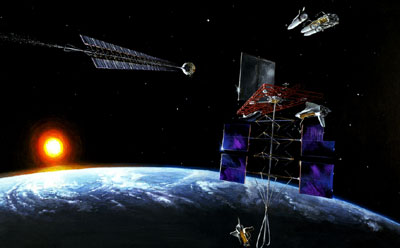|
|
 Creating orbital supply depots, like the one pictured here in this 1970s-vintage illustration, and supplying them commercially, might be a key step towards creating a true “spacefaring species”. (credit: NASA) |
Let’s add a wrinkle…
by Tom Hill
Monday, January 19, 2004
The announcement made by President Bush on Wednesday has many people excited—this author included—about the possibilities of exploring beyond Earth orbit in the next years. Returning to the Moon to prepare for trips beyond is definitely the right idea for getting humans on the move again, taking us to where we could have gone years ago. The multi-decade pause has given us time to think, though, about perhaps abandoning unsustainable sprint efforts in favor of a more reasoned expansion.
There’s something missing, though. While the language is slightly different, and the times have changed substantially since Kennedy’s challenge to land humans on the moon by the end of the decade, this new effort could take the form of an Apollo redux. Without a sustainable infrastructure built up as missions proceed, once a crew lands on the Red Planet, that bittersweet emotion of a goal met might creep back into space efforts. Granted, that would be years in the future, but small changes made now could reap huge benefits and leave behind a viable space industry.
Some space advocacy groups, asked for their opinion during the recent open debate on space policy, recommended against setting a goal like Mars for future human space exploration. Their proposal instead was to set a goal like “making us a spacefaring species.” Their point was that by achieving that goal, all the others (Moon, Mars, asteroids, etc.) would become easier. This point is inarguable: a species that can easily (and presumably cheaply) traverse space can easily choose somewhere to go. Lofty goals such as the “spacefaring species” sound great, and would be a better goal overall, but are difficult to quantify. Intermediate milestones, while possible to set, might be hard to explain for the public. I understand why a government may shy away from setting such a goal, and have an alternative proposal.
| Without a sustainable infrastructure built up as missions proceed, once a crew lands on the Red Planet, that bittersweet emotion of a goal met might creep back into space efforts. |
President Bush’s policy is pointing us in the right direction, but has set fairly long timelines. I propose setting a timetable not based on a date, but on when our space agency can fly a mission beyond Earth orbit (for me, preferably to Mars) with more than half of its starting mass launched by a commercial interest. This sounds like a lot of mass, and it is, but for any mission beyond the immediate Earth environment using chemical propulsion, more than half of the starting mission mass is fuel and oxidizer. Other forms of propulsion (nuclear-thermal, ion, etc) require propellants as well, and if their use is planned the percentage requirement can be lowered accordingly. With this type of an arrangement, NASA and its possible international partners can build the hardware for their journeys and the missions could take on propellant, in LEO, from a commercial entity. How to implement a propellants-to-LEO effort is open for discussion. I propose one here that utilizes orbiting supply depots. Frequent flights to LEO delivering propellant will allow a new commercial service provider to prove out their vehicle flying relatively cheap and replaceable cargo, warming up for eventual cheap and safe access to space for anyone desiring to go.
Again, I think the announcement made Wednesday has the ship pointed in the right direction. I look forward to developing the details and helping the goals be achieved. Thinking differently from the start can assure this plan’s place in the future of humankind.
Tom Hill (hillkid@earthlink.net) is an aerospace engineer working with weather satellites.
|
|
